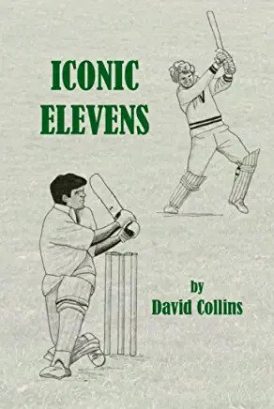Iconic Elevens
Martin Chandler |Published: 2022
Pages: 328
Author: Collins, David
Publisher: Private
Rating: 3.5 stars

As a cricket writer Yorkshireman AA Thomson had much in common with Neville Cardus. Both relied on their imaginations as much as the evidence of their own eyes. Neither was particularly strong on technical examination, or likely to getting bogged down in historical research and, important on a practical level, both wrote books that sold well to the general public. Beyond that however Thomson is largely forgotten today whereas interest in Cardus and his work is almost as strong as it ever was.
When Thomson died in June 1968 he was working on his next book, Vintage Elevens, an expansion of a series of articles that had been appearing in Playfair Cricket Monthly. The format of the book was that Thomson chose what he considered the greatest team, by year, from each of the seventeen First Class counties, thus the 1936 Derbyshire side, that of Essex in 1897, and so on. At the time of his death Thomson had completed fourteen chapters and his friend and fellow writer Denzil Batchelor completed the book with chapters on the Warwickshire side of 1911 and Worcestershire of 1964.
As far as Thomson’s beloved Yorkshire was concerned he had, presumably, left behind nothing to indicate what choice he had made and, perhaps wisely, Batchelor ducked the task of nominating a particular team and concluded the book with an overview of the White Rose’s distinguished history.
More than half a century has passed since Vintage Elevens appeared. With one addition the same counties are all still around and, with additional formats and more trophies to contest than in 1968, there have been many more winning teams than Thomson had to consider so it is perhaps surprising that it has taken so long for someone to revisit the idea. Which is exactly what retired teacher David Collins has done in this absorbing and thought provoking book.
The early pages of the book give due credit to Thomson for inspiring the idea, and then explain in general terms how Collins sees the selection procedure, before going on to the eighteen individual chapters that describe the Iconic Elevens.
The intriguing aspect of this book for readers of my vintage is that, unlike in Vintage Elevens, the entirety of the scope of the book comes within my years as a cricket lover. Accordingly I had my own ideas about the sides that should feature and, this being the sort of book that does not need to be read from start to finish, I went straight to the chapter concerning my own county, Lancashire.
My own view was that there were only two possibilities here, those being the 2011 side who finally brought to an end the 77 years of hurt by securing the County Championship title, or Jack Bond’s merry men from 1970 who won the Gillette Cup and the John Player League and in doing so helped to shape the way in which the then revolutionary limited overs game was played.
I was therefore a little surprised to see that Collins nominated the 1998 side, winners of the Gillette’s successor, the Nat West Bank Trophy and the Sunday League as well as being runners-up in the Championship. Which serves only to highlight the differences between subjective and objective points of view. The 1998 side contained a galaxy of stars that, by reputations at least, shone even brighter than Bond’s men in 1970.
Nonetheless, being hopelessly biased and one-eyed on the subject to my mind the answer must remain the almost exclusively Lancashire born and unsung group of players who lifted that title in 2011, but in moments of sober reflection I can see where Collins is coming from. He looks at the merits of my two choices before taking an extended look at the class of ’98, in the course of which he explains why he considers them to be the iconic Lancashire side of the fifty years.
Having declared my interest in the Lancastrian chapter, and making the concession I do about Collins’ judgment, it is perhaps unsurprising that I did not disagree with him on any of his other choices. One feature that is noticeable, and perhaps evidence that despite his apparent objectivity Collins does possess a pair of rose tinted spectacles, is that Durham apart, for whom it is inevitable, only the teams for Gloucestershire, Sussex and Yorkshire come from this century.
But then the most enjoyable feature of Iconic Elevens is the memories it stirs of those sunny days of my youth; the magnificence of Barry Richards at Hampshire in 1973, the star studded Somerset eleven of 1979 and the Kent side of 1970 who, in a mere ten weeks, moved from 17th and last in the table to take the title in a thrilling climax to the season.
The book is a self-published one printed by and available from Amazon but, I am pleased to be able to report, free of any of the glitches that sometimes afflict such ventures. The book has no photographs within its covers, but does have the benefit of some drawings of the main protagonists in each of the Iconic Elevens. With the exception of Mike Brearley the artist’s minimalist style skilfully captures the essence of her subjects. All in all this is an excellent book for the over sixties, and a pretty good one for everyone else.






Leave a comment